Adrian Collins's Blog, page 106
February 17, 2023
REVIEW: Clytemnestra by Constanza Casati
Constanza Casati’s debut Clytemnestra is a worthy addition to the shelf of Greek mythology-inspired retellings. Taking the oft-overlooked Spartan sister and telling her story in bursts from childhood to the aftermath of Agamemnon’s famous death, this manages to create a version of Clytemnestra who is both utterly real and adds something new to the canon. Even knowing how the story goes, I felt there was never a dull moment in this, and that is really down to the strength of Constanza Casati’s haunting writing and her brilliant focus on characterisation.
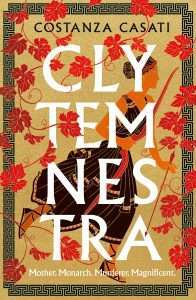 Told in burst from a range of key moments in Clytemnestra’s life, this account is concerned with establishing her as a strong woman, ruler and leader in her own right. It tells the familiar story from the perspective of the women who lived it–with a clear focus on agency and Clytemnestra’s role in Mycenae. This is the latest in a series of books about her and her more famous sister, Helen–but the one that stands out to me as both the most appealing to a grimdark audience and the one with the clearest focus. Both Jennifer Saint’s Elektra and Claire Heywood’s The Daughters of Sparta, where Clytemnestra takes up a large role, ultimately cover a far larger chunk of story, and while excellent books in their own right, end up less character-driven.
Told in burst from a range of key moments in Clytemnestra’s life, this account is concerned with establishing her as a strong woman, ruler and leader in her own right. It tells the familiar story from the perspective of the women who lived it–with a clear focus on agency and Clytemnestra’s role in Mycenae. This is the latest in a series of books about her and her more famous sister, Helen–but the one that stands out to me as both the most appealing to a grimdark audience and the one with the clearest focus. Both Jennifer Saint’s Elektra and Claire Heywood’s The Daughters of Sparta, where Clytemnestra takes up a large role, ultimately cover a far larger chunk of story, and while excellent books in their own right, end up less character-driven.
The key theme to mention here is feminine rage. Clytemnestra is a woman ambitious and driven, determined to carve out power for herself in a world stacked against her. She experiences great personal tragedy at various points in her life–as those of you who are familiar with Greek mythology will be aware of–and uses it to grow stronger, to shape herself into a figure of authority. Until she hits her breaking point. I’ve always found her to be an incredibly interesting figure, far more so than Helen, whose main quality is her beauty. Clytemnestra is fierce and intelligent, loving and ferocious. And it is brilliant to see her be given this space, a full novel, over 450 pages, to be herself, to bloom and show all the facets of her personality.
It is clear that Constanza Casati has done her research, drawing on a range of sources outside of the most obvious Homer. This has lead to a well-rounded, tense and perfectly paced story with nuance–and an ending that is surprising even to those who know what to expect. A highlight of the genre and a must-read for those who enjoy mythology and retellings.
Read Clytemnestra by Constanza CasatiThe post REVIEW: Clytemnestra by Constanza Casati appeared first on Grimdark Magazine.
February 16, 2023
REVIEW: Conan – Blood of the Serpent by S. M. Stirling
Conan – Blood of the Serpent marks the long-awaited return of the fantasy genre’s most famous barbarian hero to long-form prose. First introduced to the world by Robert E. Howard in a 1932 issue of Weird Tales magazine, the Conan stories have had a tumultuous publication history. After Howard’s 1936 suicide, hardback releases by Gnome Press in the 1950s and enduring support in the pages of fanzines like Amra kept the barbarian from disappearing into obscurity. Editors L. Sprague de Camp and Lin Carter further popularized Conan in the 1960s with a series of paperback novels that blended Howard’s original material, “posthumous collaborations” based in part on unpublished fragments and outlines, and stories created whole cloth by de Camp and Carter. While the publishers and contributors involved shifted multiple times in the decades to follow, paperbacks featuring Conan the Cimmerian were a ubiquitous presence on bookstore shelves until the late 90s, when releases slowed to a trickle. Harry Turtledove’s Conan of Venarium was released as late as 2003, but the recent trend has been to reject pastiche and return to Howard’s original texts, excised of the occasionally controversial embellishments and expansions of later authors. Some fans argue that the original Howard work is all we need, but others still yearn to see Conan set out on new adventures. The past few years have shown a tentative few steps back in that direction with the 2019 publication of two novellas—one by John C. Hocking and one by Scott Oden—serialized as part of Marvel’s Conan the Barbarian and The Savage Sword of Conan comic book series. Oden was also commissioned to write a short story for inclusion with the Conan Unconquered (2019) video game. Perhaps signaling the start of a greater revival, Conan – Blood of the Serpent is the first original full-length novel to feature Conan in nearly twenty years.
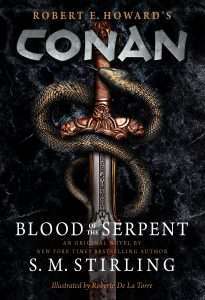 Positioned as a prequel to the 1936 Howard novella Red Nails, Conan – Blood of the Serpent opens with the titular barbarian languishing in Sukhmet, a backwater village in Stygia, the Hyborian Age’s antediluvian precursor to ancient Egypt. Employed as a scout in Zarallo’s Free Companions, a multi-ethnic mercenary band hired by the Stygians to guard against Darfari raiders, Conan seems to spend as much time riding herd on drunk and idle sell-swords as dealing with foreign threats. The monotony of garrison life is shaken up, however, when he encounters a new addition to the band: Valeria. Formerly of the Red Brotherhood, the blonde and blue-eyed pirate’s beauty is matched only by her lethality. Conan is instantly smitten. Fiercely independent and all too accustomed to advances from her compatriots, Valeria is unimpressed. Conan isn’t the only one pursuing Valeria; while Conan is content to bide his time and prove his merits, an arrogant Stygian commander named Khafset proves himself less willing to take no for an answer. His fixation turns to murderous hatred, forcing Valeria and Conan to embark on a desperate journey across untamed lands, contending with threats both terrestrial and supernatural. Together and apart, Conan and Valeria carve a bloody swath across deserts and jungles, their footsteps dogged by the evil magic of the serpent-worshiping Stygian priesthood.
Positioned as a prequel to the 1936 Howard novella Red Nails, Conan – Blood of the Serpent opens with the titular barbarian languishing in Sukhmet, a backwater village in Stygia, the Hyborian Age’s antediluvian precursor to ancient Egypt. Employed as a scout in Zarallo’s Free Companions, a multi-ethnic mercenary band hired by the Stygians to guard against Darfari raiders, Conan seems to spend as much time riding herd on drunk and idle sell-swords as dealing with foreign threats. The monotony of garrison life is shaken up, however, when he encounters a new addition to the band: Valeria. Formerly of the Red Brotherhood, the blonde and blue-eyed pirate’s beauty is matched only by her lethality. Conan is instantly smitten. Fiercely independent and all too accustomed to advances from her compatriots, Valeria is unimpressed. Conan isn’t the only one pursuing Valeria; while Conan is content to bide his time and prove his merits, an arrogant Stygian commander named Khafset proves himself less willing to take no for an answer. His fixation turns to murderous hatred, forcing Valeria and Conan to embark on a desperate journey across untamed lands, contending with threats both terrestrial and supernatural. Together and apart, Conan and Valeria carve a bloody swath across deserts and jungles, their footsteps dogged by the evil magic of the serpent-worshiping Stygian priesthood.
As a new Conan adventure, Conan – Blood of the Serpent is largely successful. Numerous authors have shown that Conan can be a deceptively tricky character to portray with any accuracy. Decades of inconsistency and, for lack of a better term, “flanderization” across various forms of media have led to a multitude of Conans that sometimes wildly diverge from his depiction in the original tales. Too often the result is a brutish, monosyllabic, meat-headed jock rather than the cunning, pantherish figure created by Howard. In Conan – Blood of the Serpent S. M. Stirling demonstrates a nuanced grasp of the character. His Conan is appropriately deadly in combat and takes the direct approach when need be, but he’s also just as likely to use clever strategy or stealth to deal with obstacles. In The Phoenix on the Sword, the very first Conan short story, Howard described the character as possessing “gigantic melancholies and gigantic mirth.” While so many depictions of Conan give us the former, grim-faced and dour, Stirling goes out on a limb a little and shows us some of that mirth, in a way we don’t often get to see. His Conan is downright jovial at times. Throughout the novel, Stirling displays a reassuring understanding of Conan’s character.
While Stirling delivers an entertaining Conan story, what he does NOT do is emulate Robert E. Howard’s style. I suspect this will be the most controversial aspect of the book for longtime Conan fans, as the most celebrated pastiche novels (i.e., the ones still talked about today, as opposed to lesser efforts) sought to pair an authentic-feeling Conan with prose that feels like something Howard would have written. And Stirling doesn’t do that, he simply declines. The book is written in a thoroughly modern style, and Stirling doesn’t go out of his way to pepper the text with Howard’s favorite expressions. Where Howard’s Conan tends to express his reflections and feelings through his actions and remarks, Stirling gives him the degree of interiority that contemporary readers are accustomed to, complete with italicized thoughts.
Not only is Conan – Blood of the Serpent a prequel to Howard’s Red Nails as advertised, I was surprised to discover that the final pages of the novel lead directly into the novella in question, with zero gap in the narrative. Titan Books wisely included Red Nails in this volume, and frankly the book would have felt incomplete otherwise. It’s a laudable move, as it allows newcomers to read a modern fantasy novel paired with one of the very best of the original Conan stories, but it also makes the contrasts between each writer’s style particularly stark. Both authors give the reader numerous scenes of intense combat against both man and beast (Stirling’s Conan slaughters a veritable zoo’s worth of African wildlife), but I was surprised to find it was Howard that went further in graphic detail when describing bloody swordplay. Also, perhaps inevitably due to the long-form novel format, Stirling struggles to maintain the propulsive, breakneck pacing seen in Howard’s short stories and novellas. Parts of Conan – Blood of the Serpent feel padded by comparison. The novel begins with not one but TWO tavern brawl scenes, whereas Howard would have cut to the literal chase and started his tale at the point in the narrative Stirling only reaches after a hundred pages. On the other hand, the extra space gives Stirling more breathing room for characterization. He has the space to directly show us aspects of Conan’s character (his mastery of wilderness survival, for example) that are generally mentioned in passing in Howard’s own work. Non-white characters are also given more dimension, while Howard tended to rely on the stock archetypes his pulp audience would have been familiar with.
Conan – Blood of the Serpent is blatantly a Conan novel written by S. M. Stirling, and not something that could be mistaken as a lost Howard tale. This is all die-hard Conan fans need to know. If Howard’s distinctive blood and thunder authorial style is a requirement for a prospective reader to enjoy a Conan story, this book may be skipped. But newcomers to Conan and existing fans who love the character and are open to other voices are encouraged to take a look. This volume delivers an engaging and approachable new adventure along with one of the very best of the classic stories. Regardless of whether or not future novel plots are directly connected to the events of the original stories, I would love to see Titan Books continue to package new stories with the classics.
Read Conan – Blood of the Serpent by S. M. StirlingThe post REVIEW: Conan – Blood of the Serpent by S. M. Stirling appeared first on Grimdark Magazine.
February 15, 2023
Guest Post: How to Research by Anna Stephens
Anna Stephen’s latest novel, The Jaguar Path, is out now from Harper Voyager (read our review here), and we’re very excited to be sharing this exclusive article about her research for the series with Grimdark Magazine readers.
How to Research by Anna Stephens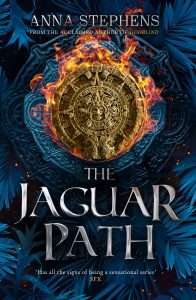 One of the most freeing things for an author of speculative fiction is their ability to create entire worlds, societies and magic systems from scratch. They can build their own universe, as well as the characters who move through it, making up their own rules as they go. And yet, the amount of research into real world topics required to craft these unique locations can be enormous. Anna Stephens takes us through some of the topics they researched for the Songs of the Drowned trilogy, a world of monsters, magic, jungles and complex societies, to highlight the many and varied areas of knowledge needed to craft an epic fantasy trilogy about empire-building and the legacy of colonialism.
One of the most freeing things for an author of speculative fiction is their ability to create entire worlds, societies and magic systems from scratch. They can build their own universe, as well as the characters who move through it, making up their own rules as they go. And yet, the amount of research into real world topics required to craft these unique locations can be enormous. Anna Stephens takes us through some of the topics they researched for the Songs of the Drowned trilogy, a world of monsters, magic, jungles and complex societies, to highlight the many and varied areas of knowledge needed to craft an epic fantasy trilogy about empire-building and the legacy of colonialism.
When I started thinking about the concepts and themes for the Songs of the Drowned trilogy, I knew I wanted to do something different and bigger compared with the Godblind trilogy. A totally different world, with a different environment for my characters to navigate and move within. But more than that, I wanted to explore bigger and more important themes. The Godblind trilogy was a sort of trial run in that I touched on ideas of conquest and enslavement, while in the Songs of the Drowned they are the central pillars of the narrative. This immediately presented me with three avenues of research, each of them daunting but vital: a place, with all its attendant flora, fauna, weather, geology, geography and how people lived and moved within it; colonialism, empire, conquest, politics and resistance; and enslavement, prejudice, and why and how people can come to believe it’s right that they “own” others. It was a big decision to tackle subjects with such a difficult and traumatic legacy for much of the world, so I needed to approach it with the right mindset and make sure that I researched, explored and learned as much as I could before I ever started writing. Some people research alongside writing, and I did that as well, but I gave myself about eight months of solid research on the above topics – and approximately eleventy billion other things – while making detailed notes on character and plot ideas first.
First of all, I did a few solid months on worldbuilding while I let ideas for the story itself bubble away in my subconscious. I’d chosen an environment purely based on a dream I had, though all I could remember of it was an image of bare feet standing in rich black soil surrounded by verdant greenery. This told me my environment was hot, possibly tropical, and rich in plant life. I was intrigued by why the person didn’t have shoes on – and they, of course, ended up being Xessa, the deaf eja who works with her service dog Ossa to kill the Drowned and bring water to the Sky City. Worldbuilding is something I really enjoy doing – I’ve even produced an online course about it – and I took a far more structured approach to creating the peninsula of Ixachipan than I ever did with Rilpor and its neighbours, which grew organically over the decade and a half from first draft to publication. That said, it didn’t originally begin as a peninsula. I wondered if it might be more land-locked than just having Barazal as a neighbour, and my editor at the time, Jack Renninson, suggested making it a peninsula for the very simple and compelling reason that I then didn’t have to worry about any other neighbouring lands and people. There are already enough within Ixachipan itself, after all. A good editor is worth their weight in gold and that was a brilliant suggestion. It also meant that, although Ixachipan itself is pretty big, there was a feeling of claustrophobia for the Tokob and Yaloh as the last free peoples outside the Empire of Songs. There was nowhere for them to go and no one left who would help them, which directly impacts the narrative.
Once I’d chosen a rainforest/limestone/hilly/monsoon-driven world, I decided to do a deep dive into Mesoamerican civilisation. I spent a good four months reading up on Mayan, Aztec and Nahua-speaking peoples. This covered all aspects of civilisation including architecture, agriculture, religion, travel, social systems, government and laws and punishment, diet, currency, clothing, and more. I wanted Ixachipan to have the look and feel of Mesoamerica without being directly lifted from a historic and still-living culture, so there were some things I researched so that I could be sure not to use them. The biggest element of Mayan culture I made sure to understand so I could exclude it was the religion. I didn’t want to take an existing religion and jam magic and monsters into it, because I didn’t know what harm that might do. Instead, I crafted a religion (or two) from scratch that worked with the environment and the seasons and gave primacy to the magic and the abilities/creatures/spirits that lived within or utilised that magic, and then adapted Mesoamerican culture to stitch it all together into something familiar but also its own unique thing. The sanctity of time and calendrical systems to the Maya was also something I wanted to nod towards without using their actual calendar(s), which is why I generally stuck with the idea of seven-day weeks and 30-ish-day months, whereas the Mayans had 18 months of 20 days (360 days) and then five ‘left over’ days that were tacked on to the end of their solar calendar. They also used a sacred calendar of 260 days, being 13 months of 20 days. And then, of course, they had the Long Count, one cycle of which came to an end on 21 December 2012 (hence the many doomsday prophecies and that terrible, terrible film that all became popular in the run up to that date). Like a fool, I decided to use the movements of Venus to show the passage of time and, let me tell
you, whether Venus is showing as the morning or the evening star or is absent from the sky means absolutely nothing when you’re trying to work out when the rainy season should begin. I spent more time than I care to remember doing fucking maths while writing this trilogy.
While all this was happening and I was making choices about measuring distance, the passage of time, what is used as currency, I was also developing the Empire of Songs and fleshing out the main arc of the story – conquest, glory, religious supremacy – and the peoples determined to maintain their autonomy. I wanted this to be more than just a trilogy of war books – the war is the backdrop against which the politics, crimes and atrocities play out and they need to play a larger part than the actual fighting.
This was the part I was most concerned about. Being respectful to the cultures inspiring my world was crucial; understanding colonialism, empire-building and notions of superiority based on blood and blood purity was likewise incredibly important. This was my third strand of research and I’m lucky enough to be friends with some very clever people and authors, and I asked them first for recommended reading. That gave me a broad basis to
work from, and from there I moved into much more specific territory: what post-colonialism could look like, the generational trauma of enslavement, how politics and religion and so-called science played their parts in white supremacy, racism, and ‘justifications’ for the enslavement of people. And, of course, the stories and history of enslavement itself.
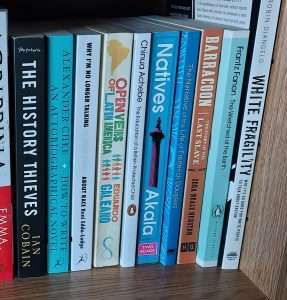

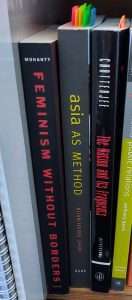
There’s always more to learn, and with big themes like these, you can’t cut corners. But at the same time, there has to come a time where you stop the reading and start the writing. In my case, I didn’t quite stop the reading, so there were several times during the drafting of The Stone Knife where I had to make hasty notes for myself and then continue writing as if that snippet of information had been known from the start.
Lastly, in my case, I hired a sensitivity reader/cultural expert to ensure that my cultural appreciation hadn’t become appropriation. He was also an author of translated myths and histories of the Nahua-speaking peoples, and his book Feathered Serpent/Dark Heart of Sky is excellent and eye-opening at the same time.
The Songs of the Drowned was a big and intimidating project I’d set myself, and I regretted it immensely at times, but I’m so pleased I decided to push myself to write this trilogy. I’ve grown as a writer, both in craft and worldbuilding ability, and I’ve definitely learned more about world history
and the specific evils of imperialism.
My advice to anyone thinking they might not have the skills or knowledge to tackle a big story is: do it anyway. Give yourself the time to do the research and be as thorough as you possibly can be. There’s always more to learn and even if all of it doesn’t end up in the book, it forms a broader understanding for you as a person and helps you curate the choices you do make. With worldbuilding, you can start literally from the ground up – what is the earth like beneath your characters’ feet? This determines the richness and type of flora and fauna, which can affect the weather systems and how your characters live and thrive or merely survive. Landscape determines threats that may have nothing to do with other characters, and from there you layer up your knowledge of the environment to people, cultures, civilisations – all of which shape your narrative. Take the same approach to your themes. Build on your foundations and make sure you have solid, broad knowledge, and then get more specific afterwards. Specialise. Diversify. Fall down the rabbit holes and clamber back out. Ask for help, have difficult conversations with clever people – and pay them for it! – hire experts, and do your best.
As writers, we can only ever write to the level of our experience, knowledge, and imaginations. As long as we’ve done everything we can to understand the topic we’re writing about, and have done the research and utilised experts’ input where possible, then we can be confident that we’ve produced the most accurate, in-depth, realistic and respectful narrative we can for the writer we are at that time.
Read The Jaguar Path by Anna StephensThe post Guest Post: How to Research by Anna Stephens appeared first on Grimdark Magazine.
February 14, 2023
REVIEW: Obsidian: Awakening by Sienna Frost
Obsidian: Awakening is a grimdark fantasy inspired by the desert cultures of the Mongolian nomads and the Bedouins. As the first book in an intended series, it explores the world of two warring cultures and, at its heart, is a story about people who find resilience and love in the absence of hope and kindness.
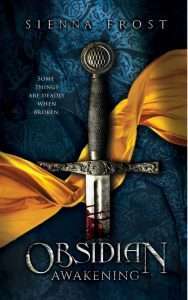 One such person is Hasheem: a male escort-turned-assassin who becomes a fugitive after a woman is found dead in his room. Forced to flee the Salasar city of Rasharwi, he returns to his homeland of the White Desert, from which he was taken as a child. Here, he encounters Djari, the daughter of a powerful Shakshi tribe leader, who is prophesised to end the long and bloody war between the Shakshi people and the Salasar Empire–for better or worse.
One such person is Hasheem: a male escort-turned-assassin who becomes a fugitive after a woman is found dead in his room. Forced to flee the Salasar city of Rasharwi, he returns to his homeland of the White Desert, from which he was taken as a child. Here, he encounters Djari, the daughter of a powerful Shakshi tribe leader, who is prophesised to end the long and bloody war between the Shakshi people and the Salasar Empire–for better or worse.
Obsidian: Awakening is told through numerous point-of-view characters, from both sides of the conflict. This narrative choice works well: readers are unable to easily determine which characters are truly ‘good’, and it lays the groundwork for maximum emotional devastation when the two sides finally collide in later books. However, this narrative choice could have been even more effective if there were fewer POV characters—especially those belonging to side characters whom we meet once and then never again. A Dramatic Personae—and a map—would have also been helpful.
Nonetheless, the diversity and breadth of Sienna Frost’s characters is arguably the book’s greatest strength. Almost all the main characters in Obsidian: Awakening toe the line between duty and desire, and Djari’s oracle brother Nazir is a great example of this. He is repeatedly shown throughout the book to make tough decisions with devastating consequences—sometimes even at his own expense—to serve the greater good of his tribe.
Salar Muradi and his Shakshi wife Zahara are another highlight. Having been stolen from the White Desert and forced to marry Muradi, Zahara determinedly regards her husband with hatred. However, much to Muradi’s despair, this only makes her more desirable to him. Their complex relationship is utterly gripping to read, and their fraught, fractious exchanges are easily my favourite parts of the book. In fact, Muradi alone is such an interesting character. A charming and intelligent villain with all the world on his shoulders, I could read about his political machinations and dangerously ill-advised love for Zahara all day.
Unfortunately, main characters Hasheem and Djari are easily the weakest of the cast. I much prefer the politically charged, family drama segments in Rasharwi to the more action-based scenes in the White Desert. Considering much of the story revolves around Djari’s destiny and her relationship with Hasheem, this was a bit of problem for me. I found my interest waning during the middle of Obsidian: Awakening where the scenes in the desert become far more numerous, and there are very few POV changes away from Hasheem.
There are also several, completely unnecessary and distasteful instances of sexual assault. I know this is a grimdark book, but rape is a topic that needs to be handled sensitively, irrespective of the genre it is being written in. In Obsidian: Awakening, such scenes serve only to demonstrate the sheer villainy of a character, and the traumatic aftermath is never adequately explored.
Sienna Frost deploys a notably pretty writing style and has a lovely flair for vivid description. However, her delivery at times can be too lengthy or involved. Dialogue is often followed by an unnecessary internal monologue, or a chunky passage of clarifying prose. A similar
critique can also be applied to Frost’s worldbuilding: whilst she has clearly put a lot of thought, care and effort into crafting such a rich and believable world, information about that world is often delivered as large passages of exposition instead of being permitted to bleed
through the prose naturally. At times, this makes for slow and frustrating reading.
Overall, Obsidian: Awakening is a unique and well-realised grimdark fantasy. However, the lengthy prose and occasional insensitivity regarding heavier topics wore on me over time. If such things do not bother you, you will find much to love in this rich, character-driven book.
Read Obsidian: Awakening by Sienna FrostThe post REVIEW: Obsidian: Awakening by Sienna Frost appeared first on Grimdark Magazine.
February 13, 2023
REVIEW: The Crane Husband by Kelly Barnhill
The Crane Husband is an unsettling folk horror by World Fantasy Award-winning author Kelly Barnhill. This expertly written novella provides a frank depiction of domestic violence within a contemporary reimagining of the traditional Japanese folktale, Tsuru Nyōbō, or the Crane Wife.
 There are many variations on the Crane Wife tale within Japanese folklore. A common version of the story involves a poor man who rescues an injured crane, nursing it to health before releasing it back into the wild. Soon afterwards, a beautiful woman appears at his doorstep. They fall in love and get married, but the couple are desperately poor. The wife is a talented weaver, and they build a business selling her handwoven clothing at the market. The weavings bring the couple prosperity, but the wife insists that her husband never watch her weave. The husband soon becomes greedy, forcing his wife to weave more and more, unsympathetic to her declining health. Unsatisfied with her progress, he spies on his wife and discovers that she is actually a crane plucking out her own feathers to weave into the loom. The crane wife sees him and feels betrayed by his broken promise. She flies away, never to return, and leaves her husband behind unable to earn a living on his own. The Japanese folktale has inspired a number of modern authors and artists, including a popular musical version by Portland-based indie rock band, the Decemberists.
There are many variations on the Crane Wife tale within Japanese folklore. A common version of the story involves a poor man who rescues an injured crane, nursing it to health before releasing it back into the wild. Soon afterwards, a beautiful woman appears at his doorstep. They fall in love and get married, but the couple are desperately poor. The wife is a talented weaver, and they build a business selling her handwoven clothing at the market. The weavings bring the couple prosperity, but the wife insists that her husband never watch her weave. The husband soon becomes greedy, forcing his wife to weave more and more, unsympathetic to her declining health. Unsatisfied with her progress, he spies on his wife and discovers that she is actually a crane plucking out her own feathers to weave into the loom. The crane wife sees him and feels betrayed by his broken promise. She flies away, never to return, and leaves her husband behind unable to earn a living on his own. The Japanese folktale has inspired a number of modern authors and artists, including a popular musical version by Portland-based indie rock band, the Decemberists.
Kelly Barnhill’s novella is narrated by a fifteen-year-old girl living in an old farmhouse in the American Midwest. Her father passed away when she was a young girl, leaving her widowed mother to care for her and her younger brother.
The Crane Husband takes place in a near future when the farmers’ jobs have been displaced by drones that work the cornfields. The family survives on income from the mother’s artistic weavings. However, the responsibility of caring for her children proves too much to bear, leaving the teenaged narrator to manage household finances and serve as primary caregiver for her younger brother.
Then one day the mother brings home a menacing six-foot-tall crane, with whom she has fallen in love. The bespectacled crane soon becomes violent toward the mother, who is constantly covered with cuts and bruises. Despite this abuse, the mother is unwaveringly devoted to her crane husband. She neglects her family and the world around her to focus on weaving her masterpiece, as demanded by the crane. Meanwhile, local social workers have become seriously concerned regarding the welfare of both children.
Although at first glance The Crane Husband may seem like a simple gender-swapped version of the traditional Japanese folktale, Kelly Barnhill’s story plunges deeper into violence and horror. The Crane Husband takes an unflinching look at the horrors of domestic violence, including both physical and emotional abuse. The cycle of cruelty extends to the children, who live in fear of the crane husband but are also afraid of being taken away to foster care.
The Crane Husband is the darkest work by Kelly Barnhill to date, her prose burning with increasing intensity as she immerses us in an all too realistic world of domestic violence and artistic obsession.
4.5/5
READ THE CRANE HUSBAND BY KELLY BARNHILLThe post REVIEW: The Crane Husband by Kelly Barnhill appeared first on Grimdark Magazine.
February 12, 2023
REVIEW: A House with Good Bones by T. Kingfisher
Kingfisher combines Lovecraftian horror with a charming sense of humor in A House with Good Bones, her new Southern Gothic novel about unearthing long-lost family secrets.
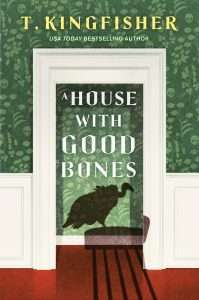 Kingfisher has crafted an irresistibly delightful narrator in Samantha Montgomery, a thirty-two-year-old post-doctoral scholar in archaeoentomology, a field at the intersection of archaeology and entomology. As the novel opens, Sam has returned to her family home in North Carolina. The bad omens start immediately, as Sam is greeted by a vulture perched on their mailbox, keeping a close eye on the house.
Kingfisher has crafted an irresistibly delightful narrator in Samantha Montgomery, a thirty-two-year-old post-doctoral scholar in archaeoentomology, a field at the intersection of archaeology and entomology. As the novel opens, Sam has returned to her family home in North Carolina. The bad omens start immediately, as Sam is greeted by a vulture perched on their mailbox, keeping a close eye on the house.
Sam is alarmed at the sight of her mother, who has lost substantial weight and seems unusually anxious. The house itself feels strange, with its brightly colored walls now painted a dull white and old decorations from her late grandmother on display throughout the home. Sam is understandably worried about her mother, determined to uncover what is driving her strange behavior.
Sam is an absolute joy as narrator of A House with Good Bones. Her droll and somewhat garrulous sense of humor kept me chuckling on almost every page. I especially enjoyed Sam’s nerdy digressions on insects and other arthropods, which acted as a lighthearted balance to the dark family secrets that she eventually unearths. Sam’s humor also serves as an effective vehicle to provide biting commentary on racism and generational conflict in the Old South.
The problem with A House with Good Bones is that the main plot twist is painfully obvious from early in the book, although Sam herself is oblivious to the clues. Nevertheless, it is a treat to read Sam’s thoughts as she employs her scientific training to attempt rationalization of the irrational. Kingfisher is especially adept at presenting the mind of a scientist at work.
The horror aspects of A House with Good Bones kick into overdrive in the last fifth of the book, causing the narrative style to shift accordingly. The humor is largely missing during these final climactic scenes, replaced with enough gory detail to make any reader squirm. The final conflict is resolved too abruptly, especially given the long buildup in the first eighty percent of the novel. Ultimately the various plot threads are tied up a little too easily for my taste. Still, I greatly enjoyed the journey.
Notwithstanding its shortcomings in the final part of the book, A House with Good Bones is a charming and highly entertaining read. Although I was underwhelmed by its rather predictable horror aspects, Kingfisher kept me smiling throughout most of the novel.
4/5
Read A House With Good BonesThe post REVIEW: A House with Good Bones by T. Kingfisher appeared first on Grimdark Magazine.
February 11, 2023
An Interview With Fonda Lee
Fonda Lee is the World Fantasy Award-winning author of the Green Bone Saga, beginning with Jade City and continuing with Jade War and Jade Legacy. Her latest work, Untethered Sky, is a coming-of-age novella inspired by Middle Eastern folklore. Fonda is also a black belt martial artist and a former corporate strategist.
We recently had the pleasure of discussing with Fonda Lee about the Green Bone Saga, Untethered Sky, and her future plans.
 [GdM] Five years after its publication, Jade City has been named as one of TIME magazine’s 100 Best Fantasy Books of All Time, a list that also includes such classics as Le Morte d’Arthur, Alice’s Adventures in Wonderland, and The Lord of the Rings. Congratulations! How does it feel to be included alongside such masterpieces? When you first wrote Jade City, did it feel like you had a future classic in your hands?
[GdM] Five years after its publication, Jade City has been named as one of TIME magazine’s 100 Best Fantasy Books of All Time, a list that also includes such classics as Le Morte d’Arthur, Alice’s Adventures in Wonderland, and The Lord of the Rings. Congratulations! How does it feel to be included alongside such masterpieces? When you first wrote Jade City, did it feel like you had a future classic in your hands?
[FL] When I was writing Jade City, I had no idea if it would even be published, much less if it would be critically or commercially successful. It didn’t fit neatly into any fantasy sub-genre, nor were there any comparable titles, but it was a story that excited me and that I wanted to read. I told myself that even if it didn’t go anywhere, I would be proud to have written it. So seeing these books resonate with readers and find their audience has been incredibly meaningful.
[GdM] When you wrote Jade City, did you already have a plan for the main plot points of the trilogy, or did you find that the characters took the story in unexpected directions during Jade War and Jade Legacy?
[FL] I had some sense of where I wanted to take the story if I was given the opportunity to write more books, but I didn’t have any firm plans. Only when my publisher signed me for three volumes did I start to structure the arc of the trilogy. Some of the main plot points I knew very early on; others came to me unexpectedly while I was writing, because of the characters. From the start, however, I knew that at its heart, this was a family saga, and that overriding vision drove my narrative choices.
[GdM] Your background in martial arts has clearly helped you with writing convincing action scenes. But could you discuss how your experiences as a corporate strategist influenced your writing of the economic and political aspects of the Green Bone Saga, especially with respect to Shae’s role as Weather Man of the No Peak clan?
[FL] My business background influences how I view worldbuilding, and that invariably affects the story. A fantasy world doesn’t feel real to me if the economy isn’t well thought through. If magic exists in a fictional world, I consider the way it affects how that world functions and how people live their daily lives by following the principle of, “It’s the economy, stupid.”
Writers always put something of themselves and their experiences into each story and each character, so it was enjoyable for me to write a character like Kaul Shae, the Weather Man of No Peak, who isn’t just a great fighter, but who can propose trade embargos, negotiate business alliances, and set in motion long-running marketing campaigns to give her clan the edge.
[GdM] You are especially adept at drawing the reader into a story. Reading the Green Bone Saga feels like being an extra on the set of a movie, up close and personal with all the action and drama. Could you describe your approach to writing in this engaging style?
[FL] I’m a spare and direct writer. To me, ideal prose is lean and sharp and immersive, occasionally hitting hard with the perfect phrase or description but rarely drawing attention to itself. A lot of my creative inspiration comes from cinema so that no doubt influences my style. I want the story to visually unfold in the mind as effortlessly as possible.
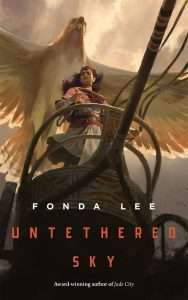 [GdM] What inspired you to pursue a new direction with your delicate coming-of-age novella, Untethered Sky?
[GdM] What inspired you to pursue a new direction with your delicate coming-of-age novella, Untethered Sky?
[FL] After the behemoth of a project that was the Green Bone Saga, I wanted and needed to write something different and to stretch different creative muscles. I’d never written a novella before, but I was excited by the idea of writing something short. I’d written an epic trilogy with a large cast of characters; this new project would be close and contained. Janloon is gritty, urban, and modern; my next story took me into ancient, wide open countryside. The Green Bone Saga is steely, bloody, and glamorous; Untethered Sky is raw, delicate and contemplative.
I was (and still am, to be honest) nervous about writing something so different from the Green Bone Saga, and worried that readers wouldn’t come along with me. But I believe it’s important, in the long run of an author’s career, at least for me personally, to explore the range of stories that interest you and push one’s storytelling craft in different directions.
[GdM] Untethered Sky incorporates mythical beasts from Persian and Arabian folklore. How did you first become interested in Middle Eastern mythology?
[FL] Actually, my interests started not with mythology but with falconry. When I was a child, I loved wildlife stories and animal companion stories like My Side of the Mountain, Julie of the Wolves, and Where the Red Fern Grows. Several years ago, I read a memoir called H is For Hawk by Helen Macdonald, about the author’s experience of training a goshawk, and I watched a fascinating, stirring documentary called The Eagle Huntress about Mongolian hunters who train golden eagles to hunt wolves. After WorldCon 2019, I went on a hawk walk in Ireland with a professional falconer. Of course, being a fantasy author, I started picturing a version of this ancient tradition involving gigantic monsters. Instead of hawks and rabbits, or even eagles and wolves, I imagined a coming-of-age wildlife memoir with rocs and man-eating manticores.
As it turns out, both rocs and manticores originate from Persian mythology. Falconry itself was birthed in the Middle East and Central Asia. It was only natural that I honor that source and create a world around my story that reflected where rocs and manticores would be found in their “natural habitat” and where “ruhking” would first develop. That led me to deep dive into researching pre-Islamic ancient Persia during the Achaemenid Empire of Cyrus the Great. What I learned inspired the kingdom I created, Dartha, and the culture and people found in it.
[GdM] The relationship between the ruhkers and rocs is beautifully written in Untethered Sky, capturing the love and respect that the human trainers have for these enormous predatory birds, as well as the inherent danger in this relationship. Could you describe how you developed the concept of the ruhker profession and how the challenges of being a ruhker reflect the real-world challenges of your readers?
[FL] I was trying to capture not only the relationship between trainer and bird, but to delve into the personal meaningfulness of the practice for someone wholly dedicated to a difficult, all-demanding, unpredictable calling. I researched falconry in depth, but more importantly, I also had the good fortune of having master falconers beta read the manuscript and tell me it rang true.
Untethered Sky is about monster hunting, but for me, it’s actually about writing. I put the obsessive drive, the emotional ups and downs of success and failure, the time and effort and sacrifice of a creative profession into Ester’s personal journey with her roc, Zahra. I hope and believe that anyone who’s ever felt a deep compulsion toward something they love to do—a hobby, an art, a sport—will find something emotionally authentic in Ester’s story.
[GdM] The worldbuilding feels so natural in both the Green Bone Saga and Untethered Sky. What is your approach for introducing the elements of worldbuilding in such a natural fashion, without any awkward info dumps?
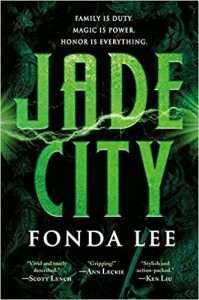 [FL] Worldbuilding is one of my favorite parts of being a fantasy and science fiction writer. There are so many things I could say about it, but I think the one crucial personal guideline I employ is to make the world feel as real and lived-in as possible. It all comes down to the tangible details that surround the characters as they move about in their daily lives.
[FL] Worldbuilding is one of my favorite parts of being a fantasy and science fiction writer. There are so many things I could say about it, but I think the one crucial personal guideline I employ is to make the world feel as real and lived-in as possible. It all comes down to the tangible details that surround the characters as they move about in their daily lives.
[GdM] How have you seen genres of science fiction and fantasy evolve over the course of your career as an author? What are thoughts on future direction of SFF?
[FL] My first novel released in 2015. Eight years isn’t all that long when it comes to to publishing timeframes, but it feels like a long time because the landscape has changed considerably, even since 2017, when Jade City came out. We’re now well past the point where fantasy is synonymous with medieval European tropes and milieus. There’s so much more variety in stories and voices, and also the lines between genres and subgenres are more porous. Authors are moving more easily than ever between traditional publishing and self-publishing, and speculative fiction as a whole has never been more culturally mainstream.
I believe all of that will continue, but we’re also in a challenging time to be a creative professional because it’s hard to stand out amid all the online noise and the sheer magnitude of entertainment available. It puts more pressure on writers be adaptable, connected, and savvy.
[GdM] You are an inspiration for many young writers. What advice do you have for young authors who are working on their first novel?
[FL] That’s very kind of you to say. My advice for new writers is always to focus on the craft and to write for themselves first and foremost. Write the story you most want to read that hasn’t been written yet. If it scratches your deepest itch, there are others out there who will want it, too.
[GdM] We are very excited about the announced TV adaptation of Jade City. Any news you can share about this new series?
[FL] Jade City was initially optioned by Peacock, but they decided last year not to go ahead with developing it. It’s now currently in the process of being optioned elsewhere; I can’t provide any further details until the ink is dry on the contract, but it’s exciting and I’ll share more once I can.
[GdM] What’s next for Fonda Lee after Untethered Sky? Any new directions you are planning to explore?
[FL] I have a Green Bone Saga short story collection, Jade Shards, coming out this summer. That’ll be my last foray into the Green Bone Saga world, at least for the foreseeable future. I just signed two new contracts to write four more books, so I’m going to be very busy for a while. One project is a collaboration with Shannon Lee, the daughter of Bruce Lee, on a young adult fantasy duology inspired by her father’s scripts, his life, and his philosophy. The other project is an adult science fiction duology that I can’t tell you about because it hasn’t been officially announced yet, but I’m very excited to get working on it and to share more about it soon.
Read Untethered Sky by Fonda Lee
The post An Interview With Fonda Lee appeared first on Grimdark Magazine.
February 10, 2023
REVIEW: The Jaguar Path by Anna Stephens
The Jaguar Path is the much anticipated second instalment in Anna Stephens’ The Songs of the Drowned trilogy. Readers may also know Stephens’ from her Godblind trilogy or her writing for the Black Library or Marvel. I am not too fond of spoilers in reviews, and hard though it will be, I will keep my review of The Jaguar Path free of any information that might ruin Stephen’s fantastic plot, but if you have yet read the first in the series, The Stone Knife, I suggest you move away.
 First off, this was a brilliantly written book. It has the same complexity and subtle nuances I hugely enjoy in Stephens’ other writing. The Jaguar Path also sticks with you. When I was not reading it, I was thinking about it, and now I have finished it, I want more. Reading The Jaguar Path was an immersive and thought-provoking experience. At the end of this, Stephens is firmly on my automatic read list.
First off, this was a brilliantly written book. It has the same complexity and subtle nuances I hugely enjoy in Stephens’ other writing. The Jaguar Path also sticks with you. When I was not reading it, I was thinking about it, and now I have finished it, I want more. Reading The Jaguar Path was an immersive and thought-provoking experience. At the end of this, Stephens is firmly on my automatic read list.
This novel is very character-driven, and we have many returning points of view from the first novel. However, The Jaguar Path picks up two traumatic years down the line from the end of The Stone Knife, so for all the characters and this world should be familiar, it is actually a very alien setting. All of the events of The Jaguar Path take place in the Singing City, the heart of the Empire of Songs, and this new sole setting feels as claustrophobic to us as it must do to the characters. Xessa is alone in a slave fighting pit, Lilla is a slave conscript in the Melody army, and Tayan is a slave to the Singer in the Source itself.
One of my favourite parts of Stephen’s writing, and The Jaguar Path is no exception, is the complexity of her characters. It is not as straightforward or reductive as good guys versus bad guys. Everyone in this novel is morally grey. Every character, at numerous points, does something unexpected and unpredictable. But this is not a case of nonsensical plot twists thrown around willy-nilly to throw the reader off; Stephens slowly revealed this masterful plot piece by piece. It is an exceedingly well-written dark fantasy with layers of politicking and betrayal. There is slightly less actual gore and violence than in The Stone Knife, but not by much, and when it is used, it is heartbreakingly effective.
I must admit, though, I personally prefer a faster-paced novel. I had the same struggle with the first book in this series, where the slow build-up (although very interesting) made me feel like I needed to make more progress with the plot. However, having had a few days
reading The Jaguar Path, where I had more time to sit and read, rather than a chapter here and there, that is more a reflection on how much time I have rather than a criticism of the writing. The writing is fantastic and deserves more of my time than I can usually give in one go. Also, the build-up is absolutely worth it because, as well as gifting us many engaging and well-formed points of view, the final third of the novel and the denouement of The Jaguar Path are spectacular. I am utterly bereft at that ending.
Everything is set up for the trilogy’s final, and probably heart-breaking, conclusion. The wait will be a torturous couple of years, but I will be grabbing hold of it as soon as I can. I want to massively thank Anna Stephens and the team at Harper Voyager for sending me a copy to provide this review for Grimdark Magazine.
5/5
Read The Jaguar Path by Anna StephensThe post REVIEW: The Jaguar Path by Anna Stephens appeared first on Grimdark Magazine.
February 9, 2023
REVIEW: Wrath of N’Kai by Josh Reynolds
Wrath of N’Kai by Josh Reynolds is a gamelit tie-in literature, specifically for Arkham Horror. I don’t play Arkham Horror but a friend of mine does and it basically seems to be a boardgame version of Chaosiums’ Call of Cthulhu, except published by Fantasy Flight Games. I have an interesting relationship with game tie-in fiction. Basically, it’s what made me the reader I am today.
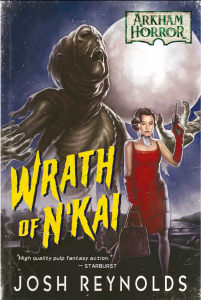 I was a fanatical consumer of Dungeons and Dragons fiction from around thirteen to nineteen with perhaps two hundred or so books under my belt. All of them five dollar paperbacks from my local Waldebooks: Dragonlance, Forgotten Realms, Dark Sun, Ravenloft, and so on. Technically, my love of the Star Wars Expanded Universe was the same as I devoured the books chiefly because of my love of Star Wars D6 by West End Games. Later, I’d read a large chunk of Dan Abnett and William King’s work in Warhammer and Warhammer 40K.
I was a fanatical consumer of Dungeons and Dragons fiction from around thirteen to nineteen with perhaps two hundred or so books under my belt. All of them five dollar paperbacks from my local Waldebooks: Dragonlance, Forgotten Realms, Dark Sun, Ravenloft, and so on. Technically, my love of the Star Wars Expanded Universe was the same as I devoured the books chiefly because of my love of Star Wars D6 by West End Games. Later, I’d read a large chunk of Dan Abnett and William King’s work in Warhammer and Warhammer 40K.
Even as a teenager, I felt they were essentially like fast food. They were filling, what I wanted, and not at all “good” for me. Some of them were things that stayed with me for decades, though, like Dragonlance Legends by Margaret Weis and Tracy Hickman. I always felt Chaosium missed the boat by not churning out Call of Cthulhu books the same way TSR did. Perhaps it was a fear that they would dilute the brand by having investigators fighting against the Mythos versus going insane or dying horribly as the stereotype of Lovecraft protagonists was.
Which is a very long winded introduction into saying that Wrath of N’Kai is book I wish I’d read twenty years ago and was a trilogy rather than a standalone. It’s exactly what I want from a Cthulhu Mythos themed adventure novel and a Pulpy throwback that hits the spot perfectly. No one will ever accuse me of having refined tastes but I read a lot (350 Goodreads ratings last year) and this is on track to being my favorite read of 2023. There’s a beauty to sincere use of adventure and classic horror movie tropes that jumps off the page.
The premise is a beautiful female cat burglar, Countess Alessandra Zorzi, has been hired to steal a mummy found by archaeologists working in Oklahoma. Existing in the world of Call of Cthulhu/Arkham Horror, a lot of her clients are occultist weirdos so this doesn’t strike her as too strange. Befriending a young cabbie named Pepper who becomes her sidekick, stalked by an insurance investigator PI out to see her jailed, and dealing with old enemies who want to see her dead–she would be an interesting protagonist even without the Cthulhu Mythos elements.
But the use of Cthulhu Mythos elements are well done and Arkham is brought to life in a rich not-entirely- realistic way that makes me feel the city is a Waterdeep or Mos Eisley I’d love to visit. I admit part of the fun is picking out all the references I get. The Order of the Silver Twilght? I remember those guys! They were the villains of The Shadows of Yog Sothoth! Is that a reference to HP Lovecraft’s The Mound? Why, yes it is.
The Countess is really the best reason to enjoy this book, though, as she has a kind of Phryne Fisher 1920s style free spirited energy and enjoyment factor that makes her a tremendous read. She’s not a real countess, she drove an ambulance in WW1, and keeps a pistol for dealing with disgruntled clients as well as victims both. It says what I think best needs to be said about this book that I really wish I had more books about her and Pepper robbing evil wizards across Europe or the Americas. Kudos also to the cover artist for successfully evoking what sort of book this is by the art style.
Read Wrath of N’Kai by Josh ReynoldsThe post REVIEW: Wrath of N’Kai by Josh Reynolds appeared first on Grimdark Magazine.
February 8, 2023
REVIEW: Dead Space 2023
Dead Space (2023) is a remake of the classic 2008 video game. It is a welcome revival of a franchise that briefly was on top of the world with animated movies, comics, and multiple sequels before crashing into a spectacular inferno with the incredibly ill-received Dead Space 3. The premise is simple: in the far future, humanity discovers a series of dark mystical artifacts called Markers that drive people insane before transforming them into horrible zombie-like monsters.
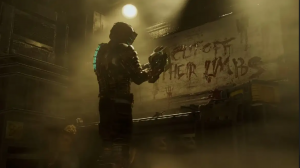 Dead Space is something of a victim of its own success as the premise is excellent but somewhat limited. The mystery of the Markers, Unitology, and the forces behind them both were intriguing but the games never really added behind them. Familiarity breeds contempt and the universe started to feel limited as well as static rather than constantly growing. Resident Evil and Silent Hills were always growing, while Dead Space didn’t. Oh and the fact the third game was an action multiplayer game in a series about survival hero.
Dead Space is something of a victim of its own success as the premise is excellent but somewhat limited. The mystery of the Markers, Unitology, and the forces behind them both were intriguing but the games never really added behind them. Familiarity breeds contempt and the universe started to feel limited as well as static rather than constantly growing. Resident Evil and Silent Hills were always growing, while Dead Space didn’t. Oh and the fact the third game was an action multiplayer game in a series about survival hero.
Despite this, I was really excited about the remake as the original game was easily the best of them. As a huge fan of sci-fi horror, like Alien: Isolation, I’ve always been of the mind that we could use more of it in gaming. It’s also good to continually reintroduce the best games to new console generations so that future gamers can appreciate what was fantastic. It’s why I absolutely loved the Resident Evil 2 and Resident Evil 3 remakes.
While I’ve already shared the premise of the games, the plot is a bit more specific and interesting in both this version as well as the remake. Isaac Clarke is a technician who is sent to the USG Ishimura that has lost all contact with the outside universe despite just being a mining ship. Heading with a couple of soldiers, Isaac has the mission to repair it and see to helping any survivors. Isaac has a personal motivation as well with his ex-girlfriend, Nicole, being one of the people onboard the Ishimura.
The gameplay is the biggest change this time around as it more resembles Dead Space 2’s more actionized but still scary version. You can go back to the original controls if you want but I much preferred the more streamlined and enjoyable version. The name of the game in the remake is tweaking rather than generally modifying. Virtually the entirety of the original game is present with a bunch of additions rather than trying to reinvent the wheel. There’s no “empty” nodes in leveling up either.
Genuine improvements to gameplay would include the fact the Zero G system of the game is no longer bare bones. In the areas where Isaac can move around without gravity, you are no longer restricted to a preset path but can move around at will. They’ve also removed the incredibly poor turrett section and replaced it with one that has auto-turrets that Isaac must repair. Those turrets more or less destroyed me the last time I played the game so that’s a massive improvement.
Perhaps the biggest change is the fact that the Ishimura is one gigantic open world map now rather than something you are only able to explore once. A bit like the Spencer Mansion or the Racoon City Police Department, they provide you the opportunity to go around at your leisure. There’s also the addition of sidequests that were absolutely terrible ideas in Dead Space 3 but work surprisingly well here. There’s more interactivity as well with the previously unopenable red light boxes being available to loot this time around.
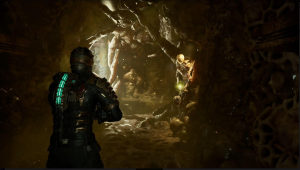
The plot is about 90% the same this time around and that’s a good thing even if I went in knowing the big “twist” that was such a shocker in 2008. I also appreciated the larger role for Nicole in this game as she’s a character that was somewhat of a Macguffin the first time around but is a fully realized entity this time. Because she and Isaac are played by their original voice actors, we also have the change to their characters that they’re a pair of middle aged lovers rather than twenty somethings.
Lore-wise, we actually get more nods toward Dead Space 3 and the revelations there. At least some of the Unitologists aren’t complete morons this time around and are full-on Call of Cthulhu cultists who want to bring about the end of reality for their dark masters. Given the games have always been heavily HP Lovecraft inspired, I’m not against this and hope this is a sign we’re going to eventually get a Dead Space 4.
In conclusion, I think this is a solid and impressive remake. I am a huge fan of HP Lovecraft cosmic horror but like when people take the themes and expand on them in a way that, well a 1920s oddball couldn’t, like done here. I have high hopes for the continuation of the Dead Space series and think fans of both the old game as well as ones who never gave it a shot will enjoy this too.
Play Dead Space 2023The post REVIEW: Dead Space 2023 appeared first on Grimdark Magazine.



